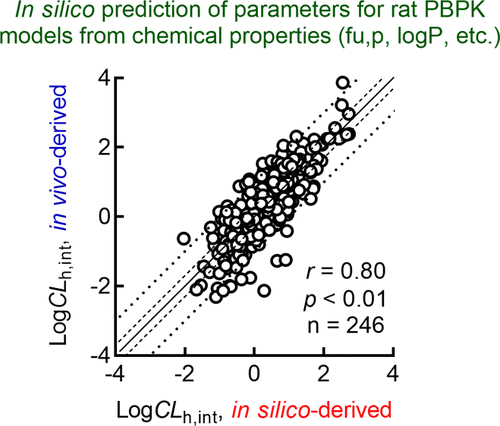当前位置:
X-MOL 学术
›
Chem. Res. Toxicol.
›
论文详情
Our official English website, www.x-mol.net, welcomes your
feedback! (Note: you will need to create a separate account there.)
In Silico Prediction of Input Parameters for Simplified Physiologically Based Pharmacokinetic Models for Estimating Plasma, Liver, and Kidney Exposures in Rats after Oral Doses of 246 Disparate Chemicals
Chemical Research in Toxicology ( IF 3.7 ) Pub Date : 2021-01-12 , DOI: 10.1021/acs.chemrestox.0c00336 Yusuke Kamiya 1 , Kentaro Handa 2 , Tomonori Miura 1 , Mayu Yanagi 1 , Kazuki Shigeta 1 , Shiori Hina 1 , Makiko Shimizu 1 , Masato Kitajima 2 , Fumiaki Shono 3 , Kimito Funatsu 3 , Hiroshi Yamazaki 1
Chemical Research in Toxicology ( IF 3.7 ) Pub Date : 2021-01-12 , DOI: 10.1021/acs.chemrestox.0c00336 Yusuke Kamiya 1 , Kentaro Handa 2 , Tomonori Miura 1 , Mayu Yanagi 1 , Kazuki Shigeta 1 , Shiori Hina 1 , Makiko Shimizu 1 , Masato Kitajima 2 , Fumiaki Shono 3 , Kimito Funatsu 3 , Hiroshi Yamazaki 1
Affiliation

|
Recently developed computational models can estimate plasma, hepatic, and renal concentrations of industrial chemicals in rats. Typically, the input parameter values (i.e., the absorption rate constant, volume of systemic circulation, and hepatic intrinsic clearance) for simplified physiologically based pharmacokinetic (PBPK) model systems are calculated to give the best fit to measured or reported in vivo blood substance concentration values in animals. The purpose of the present study was to estimate in silico these three input pharmacokinetic parameters using a machine learning algorithm applied to a broad range of chemical properties obtained from several cheminformatics software tools. These in silico estimated parameters were then incorporated into PBPK models for predicting internal exposures in rats. Following this approach, simplified PBPK models were set up for 246 drugs, food components, and industrial chemicals with a broad range of chemical structures. We had previously generated PBPK models for 158 of these substances, whereas 88 for which concentration series data were available in the literature were newly modeled. The values for the absorption rate constant, volume of systemic circulation, and hepatic intrinsic clearance could be generated in silico by equations containing between 14 and 26 physicochemical properties. After virtual oral dosing, the output concentration values of the 246 compounds in plasma, liver, and kidney from rat PBPK models using traditionally determined and in silico estimated input parameters were well correlated (r ≥ 0.83). In summary, by using PBPK models consisting of chemical receptor (gut), metabolizing (liver), excreting (kidney), and central (main) compartments with in silico-derived input parameters, the forward dosimetry of new chemicals could provide the plasma/tissue concentrations of drugs and chemicals after oral dosing, thereby facilitating estimates of hematotoxic, hepatotoxic, or nephrotoxic potential as a part of risk assessment.
中文翻译:

基于简化的基于生理学的药代动力学模型的输入参数的计算机模拟预测,用于估计大鼠口服 246 种不同化学品后的血浆、肝脏和肾脏暴露
最近开发的计算模型可以估计大鼠体内工业化学品的血浆、肝脏和肾脏浓度。通常,计算简化的基于生理学的药代动力学 (PBPK) 模型系统的输入参数值(即吸收速率常数、体循环体积和肝脏内在清除率)以最适合测量或报告的体内血液物质浓度动物的价值观。本研究的目的是使用机器学习算法在计算机上估计这三个输入药代动力学参数,该算法应用于从几种化学信息学软件工具获得的广泛化学性质。这些在硅然后将估计的参数纳入 PBPK 模型以预测大鼠的内部暴露。按照这种方法,为具有广泛化学结构的 246 种药物、食品成分和工业化学品建立了简化的 PBPK 模型。我们之前已经为这些物质中的 158 种生成了 PBPK 模型,而文献中可用的 88 种浓度系列数据是新建模的。吸收速率常数、体循环体积和肝脏内在清除率的值可以通过包含 14 到 26 个物理化学特性的方程在计算机中生成。虚拟口服给药后,使用传统方法测定的大鼠 PBPK 模型的血浆、肝脏和肾脏中 246 种化合物的输出浓度值计算机估计的输入参数具有良好的相关性(r ≥ 0.83)。总之,通过使用由化学受体(肠道)、代谢(肝脏)、排泄(肾脏)和中央(主要)区室组成的 PBPK 模型,具有计算机衍生的输入参数,新化学品的正向剂量测定可以提供血浆/口服给药后药物和化学品的组织浓度,从而有助于估计血液毒性、肝毒性或肾毒性潜力,作为风险评估的一部分。
更新日期:2021-02-15
中文翻译:

基于简化的基于生理学的药代动力学模型的输入参数的计算机模拟预测,用于估计大鼠口服 246 种不同化学品后的血浆、肝脏和肾脏暴露
最近开发的计算模型可以估计大鼠体内工业化学品的血浆、肝脏和肾脏浓度。通常,计算简化的基于生理学的药代动力学 (PBPK) 模型系统的输入参数值(即吸收速率常数、体循环体积和肝脏内在清除率)以最适合测量或报告的体内血液物质浓度动物的价值观。本研究的目的是使用机器学习算法在计算机上估计这三个输入药代动力学参数,该算法应用于从几种化学信息学软件工具获得的广泛化学性质。这些在硅然后将估计的参数纳入 PBPK 模型以预测大鼠的内部暴露。按照这种方法,为具有广泛化学结构的 246 种药物、食品成分和工业化学品建立了简化的 PBPK 模型。我们之前已经为这些物质中的 158 种生成了 PBPK 模型,而文献中可用的 88 种浓度系列数据是新建模的。吸收速率常数、体循环体积和肝脏内在清除率的值可以通过包含 14 到 26 个物理化学特性的方程在计算机中生成。虚拟口服给药后,使用传统方法测定的大鼠 PBPK 模型的血浆、肝脏和肾脏中 246 种化合物的输出浓度值计算机估计的输入参数具有良好的相关性(r ≥ 0.83)。总之,通过使用由化学受体(肠道)、代谢(肝脏)、排泄(肾脏)和中央(主要)区室组成的 PBPK 模型,具有计算机衍生的输入参数,新化学品的正向剂量测定可以提供血浆/口服给药后药物和化学品的组织浓度,从而有助于估计血液毒性、肝毒性或肾毒性潜力,作为风险评估的一部分。











































 京公网安备 11010802027423号
京公网安备 11010802027423号